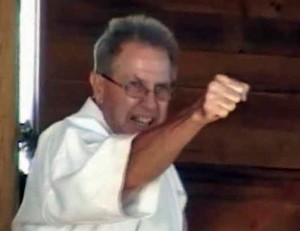Mental Strategy
by Ken Osborne, November 2000
We spend years trying to perfect our Art. Learning how to make the perfect stance, the perfect block, the perfect punch and the perfect kick. And then, we spend untold time trying to make the perfect Kata. We are constantly trying to polish ourselves, both physically and mentally. Some people spend untold years on all of these things but still don’t have a clue on how to apply all these things in a real situation or a Jiyu Kumite match.
From the beginning, our training is focused on being very structured and traditional. We train in a class atmosphere with many other people, doing the same things over and over again. Many people get stuck in that mental approach of training. At some point, each person has to break away to start using their own ingenuity. There should be no limits to your mind and how you approach the strategy of engagement. If you stop to think about it, you could purchase the best equipment in any sport, whether it be golf, tennis, anything, but no matter how good the equipment is, if you as an individual cannot make it work for you, it is useless. The mind is a powerful thing and each one of us has to start looking at our practice in this way. You have to break away and find how to make things work for you. This is the hard part. Everything else becomes secondary. Strategy has always been the secret weapon of engagement since the beginning of time, in war with untold thousands, down to the individual. You must find out through trial and error how to make your art, Shotokan, work for you.
For every action there is a reaction. Just like in the game of chess, the initial movements may be leading your opponent into a false sense of security, letting them believe they are in control when in actuality, you are leading them down a path of no return. We are all creatures of habit and a lot of the time to our own deprivation. Some of the best fighters I have known over the years were very calculated. They had a way of sizing up their opponent in a very short time, they found their opponent’s strengths and weaknesses and knew how to exploit them in short order. There is no substitute for a hands-on approach to this part of practice. I believe a lot of people feel uncomfortable about this part of practice, either out of fear or not wanting to look foolish. So they don’t spend much time on it. I believe the best approach is to find a good friend who is also interested and practice all of your ideas about strategy and application with each other out of the normal class time. I was fortunate in having Caylor Adkins and Tom Muzila as good friends and there were many times we would lock the doors of the Dojo and spend hours just fighting and experimenting.
I personally feel very fortunate that when I first started training in the early sixties, I had to hit the ground running. I was thrown into the world of tournament fighting early on. I also had the good fortune to be exposed to some very talented individuals. I have never looked at myself as having any special talents, but the one thing I had going for me was that I was never afraid to try, or to experiment with total commitment, no matter what the consequence.
You should remember to never be afraid to try anything that comes to your mind. I know that Master Funakoshi looked at fighting as the very last thing, but we all know that he himself had to use his skills in his lifetime. I believe that if you have spent many years training, that you should be able to use all your skills in a very effective way. If you feel this is a weak part of your practice, get started and remember: The mind is a very powerful thing.

